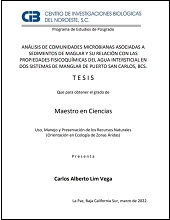Mostrar el registro sencillo del ítem
Análisis de comunidades microbianas asociadas a sedimentos de manglar y su relación con las propiedades fisicoquímicas del agua intersticial en dos sistemas de manglar de Puerto San Carlos, BCS.
| dc.contributor.advisor | González de Bashan, Luz Estela | |
| dc.contributor.advisor | Medel Narváez, Alfonso | |
| dc.contributor.author | Lim Vega, Carlos Alberto | |
| dc.date.issued | 2022 | |
| dc.identifier | https://cibnor.repositorioinstitucional.mx/jspui/handle/1001/2648 | |
| dc.identifier.uri | http://dspace.cibnor.mx:8080/handle/123456789/3116 | |
| dc.description.abstract | "El estudio de las comunidades bacterianas brinda información sobre los procesos que se llevan a cabo en los ecosistemas. Los estudios microbiológicos en manglares de la región han sido dirigidos a grupos bacterianos específicos tales como diazotróficas, desnitrificantes y solubilizadoras de fosfatos y utilizando técnicas cultivo-dependientes, por lo que gran parte de las comunidades en los sedimentos aún se desconoce. Las técnicas moleculares actuales permiten abordar estudios de comunidades con una mayor resolución pues son capaces de detectar bacterias no cultivables. El objetivo de este estudio fue analizar y comparar la estructura e índices de diversidad de las comunidades bacterianas en sedimentos de manglar y su relación con las propiedades fisicoquímicas del agua intersticial en dos sistemas de manglar ubicados en Puerto San Carlos, BCS, los cuales presentan diferencias fisonómicas marcadas, uno deteriorado por actividad industrial y el otro conservado. El análisis de comunidades bacterianas se abordó mediante secuenciación del gen 16S rRNA y se analizaron correlaciones con los factores fisicoquímicos del agua intersticial mediante análisis de correspondencias canónicas. Se encontró que los Phyla más abundantes fueron Proteobacteria, Chloroflexi y Desulfobacterota, con una abundancia mayor de los dos últimos en el sistema de manglar conservado, mientras Proteobacteria predominó en los sedimentos del sistema de manglar perturbado. Las dos familias más abundantes pertenecieron a bacterias sulfato-reductoras y correlacionaron positivamente con la concentración de sulfuros y el potencial redox del agua intersticial. Los índices de diversidad mostraron comunidades con alta riqueza de especies y no se observó un patrón en la distribución de especies relacionada con la profundidad de muestreo, pero si con los sitios muestreados, encontrando que el sitio sujeto a mayor perturbación por el efluente de la planta termoeléctrica presenta una composición distinta del sistema del manglar conservado y de los otros dos sitios del manglar perturbado. Este trabajo aporta conocimiento sobre la estructura y composición de comunidades bacterianas en sedimentos de manglares áridos y la relación con algunos parámetros del agua intersticial, permitiendo identificar patrones característicos en el sitio afectado por un efluente de industria termoeléctrica." | es |
| dc.format | es | |
| dc.language.iso | spa | es |
| dc.publisher | Centro de Investigaciones Biológicas del Noroeste, S.C. | es |
| dc.rights | Acceso abierto | es |
| dc.subject | Manglares, 16s ARNr, agua intersticial | es |
| dc.subject | Mangrove, 16s ARNr, interstitial water | es |
| dc.subject.classification | MICROBIOLOGÍA | es |
| dc.title | Análisis de comunidades microbianas asociadas a sedimentos de manglar y su relación con las propiedades fisicoquímicas del agua intersticial en dos sistemas de manglar de Puerto San Carlos, BCS. | es |
| dc.type | masterThesis | es |
| dc.dirtesis.grado | Maestría en Ciencias en el Uso, Manejo y Preservación de los Recursos Naturales | es |
| dc.dirtesis.disciplina | Ecología de Zonas Áridas | es |
| dc.dirtesis.universidad | Centro de Investigaciones Biológicas del Noroeste, S.C. | es |
| dc.dirtesis.facultad | Posgrado en Recursos Naturales | es |
| dc.description.abstracten | "The study of bacterial communities provides information on the processes in ecosystems. Microbiological studies in mangroves in the region have been directed to specific bacterial groups such as diazotrophic, denitrifying, and phosphate solubilizing and using culture-dependent techniques so that a large part of the communities in the sediments is still unknown. Current molecular techniques make it possible to approach community studies with higher resolution since they can detect non-culturable bacteria. The objective of this study was to analyze and compare the structure and diversity indices of bacterial communities in mangrove sediments and their relationship with the physicochemical properties of interstitial water in two mangrove systems located in Puerto San Carlos, BCS, which present marked differences, one being deteriorated by industrial activity and the other one being preserved. The analysis of bacterial communities was approached by sequencing the 16S rRNA gene, and correlations with the physicochemical factors of interstitial water were analyzed by canonical correspondence analysis. The most abundant Phyla were Proteobacteria, Chloroflexi, and Desulfobacterota, with a greater abundance of the last two in the conserved mangrove system. At the same time, Proteobacteria predominated in the sediments of the disturbed mangrove system. The two most abundant families belonged to sulfate-reducing bacteria and correlated positively with the concentration of sulfides and the redox potential of pore water. The diversity indices showed communities with high species richness; the distribution of species was not related to the sampling depth; however, the distribution of species was related to the sampled sites. Thus, the site with greater disturbance by the effluent of the thermoelectric plant has a different composition from the preserved mangrove system and from the other two disturbed mangrove sites. This work provides knowledge about the structure and composition of bacterial communities in arid mangrove sediments and the relationship with some pore water parameters, allowing the identification of characteristic patterns in the site affected by a thermoelectric industry effluent." | es |

